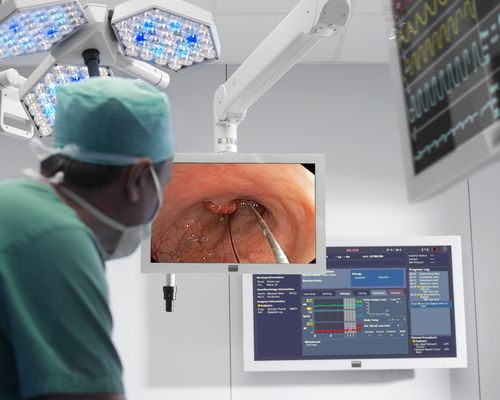Taming the controls as medical imaging reach new heights
Digitally-enhanced medicine has revolutionised health care. But operating theatres and hospital rooms for minimally-invasive, image-guided surgery more and more resemble cockpits, crammed with equipment from different makers doing different things. The 2018 "Innovation of Tomorrow" award-winning Mediate project tackled this overkill.
As populations age, a growing number of patients require major surgeries, placing a strain on healthcare services and patients alike. Thanks to technology, these interventions can be performed in a minimally-invasive way, leading to earlier diagnosis, quicker recovery times, and lives saved.
Entering through keyhole-sized openings, surgeons can’t directly see and feel what they are operating on, so effective imaging, measurement and navigation technologies are critical to guiding these minimally-invasive procedures. But with all this new kit, medical staff have struggled to keep up with the training and protocols used by different makers.
Collaboration in European projects is an ideal way to join forces to deliver innovative productsThis is where Mediate stepped in a few years ago to develop new imaging procedures, supporting devices and an integrated architecture covering all the procedural steps – from diagnosis to post-operation follow-up and decision-support – for image-guided interventions in cardiology, oncology and orthopaedics.
The integrated systems save time and help staff to concentrate on the task at hand; for example, by not having to continually re-enter patient names and monitor multiple displays via different user interfaces.
Scaling the problem … and the potential
The market potential of the different technologies pioneered in Mediate track the massive demographic changes under way as Europe and much of the western world ages and demands more and better healthcare services.Cardiovascular diseases alone are responsible for some 37% of all deaths in the EU, 26% of productivity losses, and cost the economy up to €210 billion annually. As such, common applications for minimally-invasive therapies include catheter-based treatment of tumours, aneurysms, obstructed blood vessels, heart rhythm disorders and defective heart valves.
Worldwide healthcare expenditure is currently estimated at around €6.2 trillion (US$7.6 trillion) and growing. By 2030, the global population will increase by some 1.3 billion, and the middle class by 3 billion. Due to ageing, those over 65 years’ old are projected to increase by 436 million people and urban populations by 1.5 billion, all requiring increased access to healthcare facilities and service.
Health and wellness represents as much as 25% of the EU economy when measured in terms of employment, expenditure and added value, making it the largest industry. The worldwide diagnostic imaging market is expected to grow by 6.6% annually, reaching some €29.6 billion (US$36.4 billion) by 2021.
Speaking volumes …
Volumes could be written about Mediate’s prolific output; from high-speed, high-definition imaging and processing technology, so surgeons can see what they are doing, to multi-modal registration and robotic surgical tools providing haptic feedback to surgeons.Tangible examples include an open architecture applying international standards, used in products by partners like Barco, Philips and Elekta, which integrates myriad information sources and displays. Mediate also inspired new imaging protocols developed by several partners including Leiden University Medical Centre, Institut Mines-Télécom Bretagne, Philips, Utrecht University Medical Centre, and Erasmus Medical Centre. It drove significant progress in robotic laparoscopic tools by EndoControl and Haption, and a needle-positioning system by Demcon.
Also thanks to Mediate, a new collaborative web tool for tele-consultation was developed by SurgiQual Institute, and a fast reconstruction software product by Digisens now sells some 300 licenses per year. Philips has leveraged the project results in its new motion-compensation tools for MRIs and metal artefact correction techniques with sales of over 1000 licenses in two years. Mediate architecture is also the basis for Azurion, Philip’s next-generation, image-guided therapy platform developed in collaboration with leading hospitals worldwide.
“Because there are many simultaneous changes in health care (clinically, technically, regulatory, financially) and clinical applications are diverse, no single company can cover all innovation aspects on its own,” says Herman Stegehuis of Philips, which coordinated Mediate.
Collaboration in European projects, he adds, is an ideal way to join forces and deliver innovative products to improve care, but also help to contain cost increases. “The transition from open surgery to minimally-invasive surgery saves costs through shorter hospital stays, much faster patient rehabilitation, and reduced workforce absenteeism,” he explains.
Mediate was an ITEA2 EUREKA Cluster project specialising in software-intensive systems and services for enhanced medical treatments and devices. The dedication, hard work and results of the 27 partners from Belgium, France, the Netherlands and Spain has been acknowledged in its 2017/18 EUREKA Innovation Award, 2015 ITEA ‘Business Impact’ Excellence Award, as well as in its patents and applications (well over 20 to date) and dozens of references in leading publications like IEEE Transactions on Medical Imaging, Medical Image Analysis and Journal of Cardiovascular Imaging.
Related projects
MEDIATE
Patient Friendly Medical Intervention


